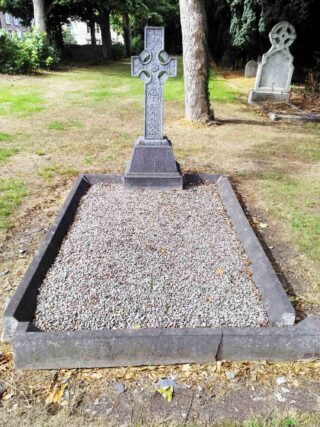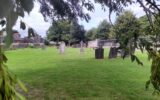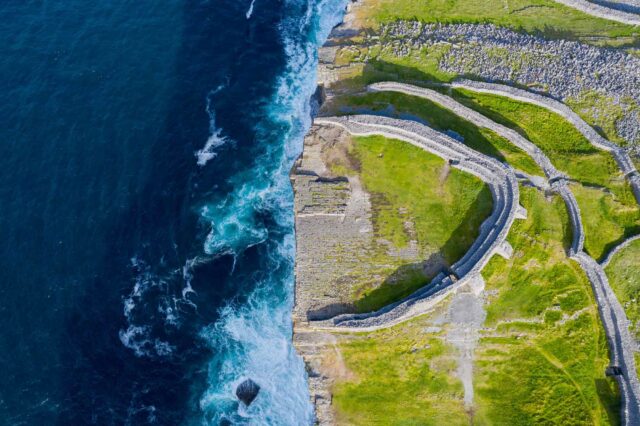Within the grounds of the Royal Hospital Kilmainham there are three graveyards. Adjacent to Bully’s Acre the oldest cemetery in Dublin city are two military graveyards for the pensioners and staff that once resided within the majestic confines of the RHK.
It is said that every headstone tells a story and those that are left here are no exception. Often broken and in disrepair these weatherworn reminders represent an individual’s life, often lost but hopefully not forgotten. This is the story of one such man, a headstone in a forgotten graveyard, a casualty of the Great War.
Charles Harold Blackburne was born on the 20th May 1876. He was educated at Tonbridge School and it was here that his interest in military life commenced. He was described as very much the dashing and handsome young officer. He was five foot and ten inches and a half in height. His weight was twelve stone. His hair was brown and he had blue eyes.
South Africa provided Charles Blackburne with opportunity and fortune. This was far removed from his home in England. Fuelled by the stories of military adventures in India and Africa he enlisted in the Imperial Yeomanry. He joined the regiment on the 9th January 1900 at Maidstone in Kent. He was 24 years old. He enlisted as a private and rapidly rose through the ranks to receive a commission of captain by late 1900.
When the Boer war erupted on the 11th October 1899 British crown forces found themselves involved in a new and difficult type of warfare. Between 1900 and 1902 Captain Blackburne was on active service with the 11th Imperial Yeomanry. Life in South Africa was vastly different to that of England. The open veldt and the excitement of the conflict were to fuel the adventurous Blackburne and reveal a life that he had only dreamed of. He was mentioned in dispatches in February 1901.
“Blackburne for the good work he has done throughout the campaign and especially during the rapid march made by colonel Firman in February 1901. He has trained and turned in to a thoroughly serviceable band of men a squadron of raw recruits.” [1]
On August 30th Captain Blackburne and his troop were patrolling the Elands river bridge crossing, an area that was a constant hive of enemy activity. As his men entered the water, a concealed group of Boer commandos opened fire on the patrol. The troops found themselves prevented from crossing the river by coils of barbed wire that had been anchored to the bed of the river. Withdrawing to the bank, Captain Blackburne shouted the order to dismount and take cover. The patrol returned fire while bullets and shrapnel sprayed around them. The first volley of Mauser bullets had claimed two casualties who now lay wounded in the open under heavy fire. Captain Blackburne assessed the situation, holstered his revolver and ordered his men to lay down a covering fire. He then crawled out to the wounded soldiers and with three of his men carried them to safety behind some rocks.[2] The Boer commandos retreated from their concealed position, and this enabled Captain Blackburne to return to camp.
For his service in the Boer War he was awarded the Kings and Queens medal. However for his decisive action at Elands river crossing he was created a companion of the Distinguished Service Order. This military order was established for rewarding individual instances of meritorious or distinguished service in times of war.
It was generally issued to officers in command above the rank of Lieutenant Colonel. For ranks like Captain Blackburnes they were made for heroic acts of gallantry just short of deserving the Victoria Cross.
On December the 11th 1901 Captain Blackburne was granted home leave and is registered as being a passenger on the ship ‘The Briton’ docking in Southampton on December 27th.
He returned to South Africa to finish his army service and then took up the position in the Transvaal repatriation department where he pursued a career in civil administration.
While stationed in the Transvaal he was to meet his future wife. Here as manager of the Transvaal government stud he met and fell in love with Miss Emily Beatrice, daughter of the Reverend Canon H.D Jones. They soon married and in the years that followed they had two children, Beatrice Audrey born on the 24th June 1907 and Charles Bertram born on the 11th September 1911. Africa had provided a new and adventurous life, crowned by domestic happiness. The sun scorched earth of the Transvaal veldt is a long way from the shores of England. However it was on this continent of Africa that Charles Harold Blackburne was to settle and begin raising his family.

As the storm clouds of war once again appeared on the horizon, Charles Blackburne returned to England and enlisted in the British army. He was appointed Captain of the 5th Dragoons (from the special reserve) on the 5th August 1914.
It was not long afterwards that Captain Blackburne was posted overseas and saw action in the Ypres sector during 1915. This area was under continuous bombardment from the German artillery. The line became untenable and Captain Blackburne regrouped his men and re – occupied the vacant front line positions. He achieved this under devastating shellfire. Captain Blackburne was wounded during this dash to hold the position but remained on duty rallying his troops and urging them to stand fast. On May 14th they marched near the town of Ypres and on May 15th Captain Blackburne was admitted to hospital. For this heroic action he received the Brevet of Major on June 3rd 1915.[3]
After a period of rest and recuperation he was transferred to Dublin and took up a position on the headquarters staff in late 1915. Living in Dublin with his family was a huge change from Africa. The war also seemed distant as life in Dublin seemed to be endless paperwork and social outings. However this changed dramatically with the Rising of Easter 1916. Captain Blackburne was stationed at the Royal Hospital Kilmainham. During this difficult and turbulent period he was once again noted for his ability and steadfastness in combat. After the flames of Rebellion were extinguished, he was promoted to the rank of Brigadier Major on April 28th 1916 and then was appointed a General staff officer 2nd grade. Two years later while still resident in Ireland he was promoted to a grade 1 staff officer on April 19th 1918.
On October 10th 1918 Charles Blackburne booked passage from Kingstown (now Dun Laoghaire) to Holyhead on the Royal Mail Steamer ‘The SS Leinster’. Accompanying him on the journey were his wife and two children. The R.M.S Leinster was built in 1897, one of a quartet of identical cross channel steamers. These vessels had been named after the four provinces of Ireland, Ulster, Munster, Leinster and Connaught. They had been built at the Cummel Laird shipyards in Birkenhead in England. The Leinster’s tonnage had been registered at 2646 tons. Because of wartime she had been camouflaged and armed with one 12-pound gun and two signalling guns. As Captain Blackburne and his family boarded the ship they noticed the large amount of passengers and crew many of which were soldiers returning from leave in Ireland. The ship was leaving port with a full complement of 771 persons on board. As the ship sailed out to the Irish channel, the thoughts of U Boat activity were present in the minds of all on board. This stretch of water was notorious for submarine activity. The ship was 16 miles out to sea when a huge explosion shook the vessel.

The twenty-seven year old German commander of UB123 Robert Ramm had sighted the ship. He had released three torpedoes. The first had missed the target. The second had struck the port bow.
Smoke filled the cabins as flames shot through the air and acrid black smoke bellowed from below decks. Panic and confusion filled the passengers and crew. Captain Birch of the Leinster tried to manoeuvre the ship in order to return to port. It was then that the third torpedo struck the vessel in the area of the engine room. The final deathblow had struck the ship and it was now beyond saving. The devastation of the Leinster had taken place in under ten minutes. As the ship sank beneath the waves, 501 of its 771 passengers and crew were lost. Among the casualties were Captain Blackburne and his two children. His wife survived.
Captain Charles Blackburne’s body was returned to the Royal Hospital Kilmainham to be buried along with his son, Peter. On Monday 21st October 1918, the autumn sunshine glistened through the stained glass windows of the hospital chapel. The service was conducted by his grace the Archbishop and very Reverend the Dean of St. Patrick’s. The chapel echoed with the voices of the choirboys of St. Patrick’s cathedral as they accompanied the music of Dr. Marchant. Blackburne’s widow stood dressed in black amidst a sea of khaki uniforms.
Their coffins were carried down the avenue and laid to rest side by side in the officer’s cemetery of the Royal Hospital. His daughter though mentioned on the headstone, is not listed at the burial service, her body lost at sea.
The inscription on the headstone reads as follows,
To the glory of God and the beloved memory of Lt. Col Charles Blackburne D.S.O, 5TH Dragoon guards, born 20th May 1876, and of Charles Bertram (Peter) his son born 3rd September 1911 who are both buried here. Also of Beatrice Audrey his daughter, born 24th June 1907. All of whom lost their lives in the sinking of H.M.S Leinster by a German submarine 10th October 1918
‘When thou passest through the waters I will be with thee’
The sinking of the Leinster took place 33 days before the armistice with Germany was signed bringing an end to the Great War.
The cold soil of Ireland is far removed from that of the warm African plains. Captain Blackburne had answered his country’s call and his family had followed him across the world. Charles Blackburne was forty-two years old, his son Peter seven and his daughter Beatrice eleven when they were killed. It is said that as one faces peril the episodes of one’s life pass before one’s eyes. As Charles Blackburne slipped beneath the waves perhaps the thoughts and memories of a life filled with adventure, love, romance and laughter passed before him.
Today, dedicated staff of the Office of Public Works maintain the Royal Hospital Kilmainham, it’s grounds and cemeteries and tours are ongoing throughout the year.
[1] London Gazette, 29 July 1902
[2] W.O 108/161
[3] W.O 95/1109
About the Author
Paul O’Brien MA, a military historian and author, works for the Office of Public Works and is currently based at the Royal Hospital, Kilmainham. The author of fifteen books, he has written extensively on the 1916 Rising, the British Army in Ireland and a number of local histories. He lives in Santry, Dublin with his wife, daughter and two cats. Stay up to date with the author at: paulobrienauthor.ie


